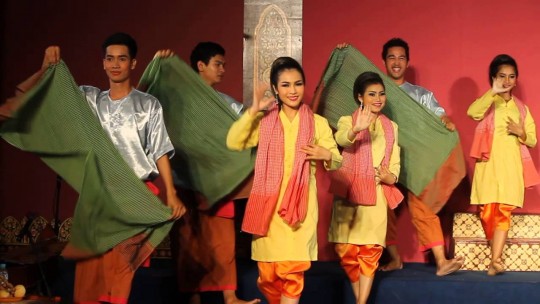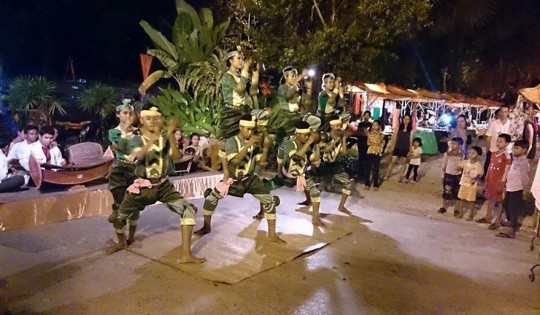Robam Krama Khmer (Khmer Scarf Dance)
Traditional Folk Dance Refers to all kinds of dances that are passed on from one generation to another and that are often linked to an ethnic group's traditional' ceremonies. In Cambodia, traditional dances mostly involve animism and express beliefs in the supernatural. When people have problems thought to have been caused by supernatural or spirits, they offer lively dances to appease them.

The Origins of Robam Krama Khmer (Khmer Scarf Dance)
Traditional dance is translated as Robam Roran in the Khmer language. Robam is a noun that refers to dance while Boran is an adjective referring to tradition. Khmer traditional dance was found to be recorded on many Cambodian temples’ walls in the 7th century.
Moreover, there are a lot of different kinds of dances; however, many of them were performed for the king. The dances began during the Angkor empire, in which they were performed at the temple according to the rites.
Folk dances are performed at religious ceremonies, festivities, and leisurely entertainment. Traditionally, all dances were performed in the village in large clearings or public areas at times of birth, marriage, death, during planting and harvesting, hunting, war, or at a feast. Some dances are related to Buddhist beliefs such as Kgnork Pailin and Trot dances. Others are performed once a year according to various spiritual and ceremonial calendars.
Khmer folk dances are highly spirited dances that follow popular themes with lively movements and gestures. Dance motifs are usually based on local legends and the everyday life of the people.
Dancers dance with easy, improvised yet composed movements that are designed to invite humor and enthusiasm, with upbeat music and rhythm. Many dances are accompanied by drums and instruments from the Mahori and Pinn peat ensemble.
Characteristics of Robam Krama Khmer or Krama Dance
Like any other traditional folk dance, the Khmer scarf dance or Robam Krama is created to demonstrate the everyday life of the old Cambodians and the important utility of this scarf in Khmer culture.
Krama is clothing that is generally worn on the neck. This clothing is handily made with yarn. You can see people wearing it on the neck or head as a representation of Khmer farmers; however, there are a lot of use cases of the scarf in Khmer culture.
In the dance, people will wear Krama to cover the head or neck from sunlight while doing household chores or going out for farming.
The dance generally begins with 10 dancers (5 women standing in front and 5 men at the back) on the stage, but it depends on the performers. The dancers start by greeting the audience. Then, one of the dancers gives a short introduction to the important use cases of Krama to the audience. While delivering a presentation, other dancers demonstrate a few usages of Krama as examples.
Then, the traditional song starts while the dancers begin to perform. Women dancers start the performance with a few sitting and the rest standing. However, it depends on the performer's preference whether to sit or stand altogether. Meanwhile, certain performances would cut off the presentation of the dancing by starting with the dance directly.
While performing, the dancers try to show the basic uses of Krama, such as folding, unfolding, and covering. As Krama can be utilized in a variety of ways to solve daily activities, the performers would try to demonstrate the different use cases of Krama to the audiences.
However, as mentioned earlier, covering, folding, and unfolding are the fundamental and necessary use cases of Krama, so you may see all of them shown on every Robam Krama Khmer stage.
In the case that there are men performers, they will come out after the women dancers. Then, they both continue to illustrate more utility examples in the dance. Moreover, the performance that includes both men and women dancers tend to give a fuller representation of Khmer farmers back in the old days and the Cambodian traditional culture.
The dance was choreographed in 2001 by an undergraduate student for his graduation piece. Changes were later made to the dance's choreography by Mr. Nguon Som Ath, Mrs. Mem Simareth, Mr. Nop Sam Bona, Mrs. Men Chanary, Ms. Pherk So Khen, and Mrs. Chhem Sokha, and Mrs. Keov Van Chan. It was officially performed by artists from the Department of Performing Arts, Ministry of Culture and Fine Arts at the 4th "National Culture Day" on April 3, 2002. The dance now forms part of the curriculum in the Faculty of Choreography at the Royal University of Fine Arts.
9 Reasons You Should Consider Khmer Krama
Everything happens for a reason, especially the creation of Krama dance or Khmer scarf dance. Back in the old days, Krama was used to solve many daily activities by Khmer people. So, here we break down the importance of Krama and how it works.
1. To create Krama, Khmer people fill the yarn using a handloom to construct it. It is very important for daily activities; however, many people these days do not know it well.
2. A small Krama can help you in any circumstances. When a cold season comes, you can cover it instead of a blanket.
3. You can use it to lie on the floor for sleeping or napping. On top of that, it can be packed meals or snacks easily. Other than that, farmers use Krama to wipe off the sweat or cover the face from sunlight.
4. People Krama to carry fruits or other relevant equipment for their needs. If there are small children, parents can put them in Krama for napping on the farm.
5. People can use Krama for showering the children every day and night. Once it is sweaty, it can be dried out for less than an hour under the sunlight.
6. Farmers like to use Krama to clean the body and sweat. Then, they clean it and use it as a pillow for an afternoon nap at the farm. Under extremely hot weather, the farmers utilize the Krama to gust the air. As a result, it helps them cool down, making them feel relieved.
7. Krama is rounded and put on the head to carry certain baskets, clay pots, or other necessary items.
8. In cooking, it is used to carry hot soup or other hot foods because Krama is thick enough to protect the heat.
9. Krama has been a close friend to many Cambodian people for many centuries as it provides a wide variety of benefits for daily life. On top of that, it represents the honesty, commitment, and hard work of the old Khmer farmers.






